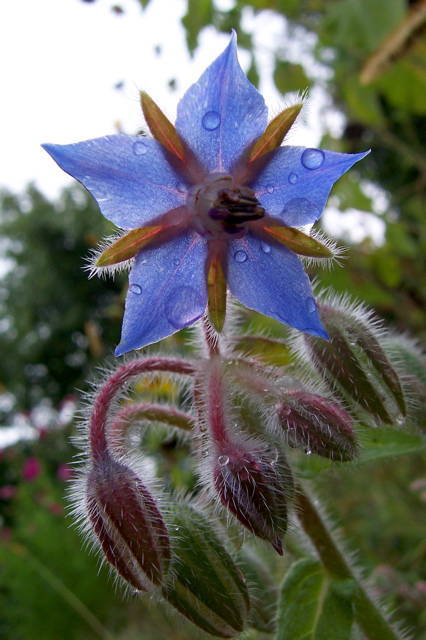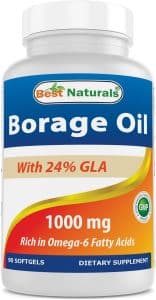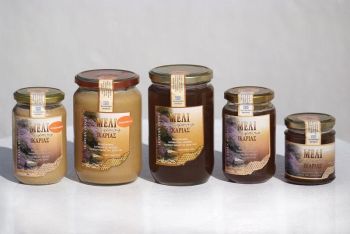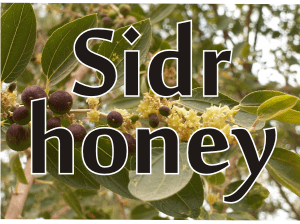Borago officinalis L. is a widely spread wild flower, used in both traditional and modern medicine, in agriculture as a companion plant and as a culinary ingredient, but also in beekeeping, as it provides high amounts of both nectar and pollen.
It’s a very spread wild flower, found almost everywhere on the planet, known in English as Borage, or Blue Borage, in French: Bourrache officinale, in Italian: Borragine, in German: Borretsch, in Spanish: Borraja, in Finnish: Purasruoho, in Romanian: Limba mielului. Only to give a few example. It seems that everybody knows this beautiful flower.
This particular type of honey has been studied by Crane et al., 1984; Maurizio and Schaper, 1994; Quayle L., 1997 (“Honeybee forage – borage: its cultivation, uses and value to bees”); Persano Oddo et al., 2000, so we do have enough data now to know what it is and how to consume it.
The Blue Borage flower:
– Botanical name: Borago officinalis
– Family: Boraginaceae (from the same family with Viper’s bugloss)
– Other names: Starflower, Burrage, Burage, Bugloss, Bourrache, Bee Plant, Cool Tankard, Langue de Boeuf, Ox-tongue or Tailwort.
– Etymology: The Celts referred to it as borrach, meaning ‘courage’. The French named it from borrache, meaning ‘hairy’ or ‘rough’,probably because of the flower’s bristly stems and leaves.
The Welsh called it the “herb of gladness”.
As for officinalis, the word is derived from the Latin officina meaning a storeroom (of a monastery) for medicines and necessaries. It literally means “belonging in an officina’, a fact that will immediately imply the plant has a medicinal, culinar or other useful feature. (this nomenclature was invented by Linnaeus)
– Native to Syria, but it was extended throughout the Mediterranean region, as well as Asia Minor, Europe, North Africa, and South America.
– It is annual, but remains in the gardens through self-seeding.
– The plant likes full sun where it tends to have a more compact habit, but it easily tolerates a partial sun exposure. The flowers last about 8 weeks after sowing and continue until the first serious frost. The color of the flowers are usually a vivid sky blue, occasionally pink and rarely white.
– It is mostly cultivated for its edible leaves and for the small black seeds, which are harvested and crushed to make borage oil, or starflower oil. It has similar properties to evening primrose oil.
– Attracts polylectic bees (bees that pollinate and gather pollen from a vast number of plants, and not have preferences like the oligolectic bees, the ones that prefer only a small number of flowering species).
How is borage honey
Borage honey is a very distinctive, clear type of honey.
It has a subtle, aromatic aroma, pale color and a light, sweet taste.
The blooms do not contain any toxic alkaloids, so the honey made is NOT a toxic honey, as it is the case with its cousin, extracted from viper’s bugloss.
In the UK, Borage honey is a specialty of East Yorkshire, a place where much of the borage is grown.
Due to the well-priced oil, farmers and beekeepers have a mutually beneficial relationship. Beekeepers get lots of honey and farmers get increased yields as their flowers are pollinated by the bees.
The amounts of nectar and pollen these flower offer are huge. In very hot summers a hive can collect 80 to 100 lb of honey from a borage field.
The content of sucrose in borage honey is not more than 15 g/100 g.
The borage honey has a low antibacterial activity, compared to that of acacia, Christmas vine (from Cuba), lucerne or orange.
Here are some characteristics of blue borage bee pollen:
– Water-soluble 52.60 amino acids (μg/mg)
– Essential water-soluble 3.90 amino acids (%)
– Protein-bound 167.19 amino acids (μg/mg)
– Essential protein-bound: 38.60 amino acids geb (%)
Medicinal use of blue borage flower:
· Removes melancholy and ease grief and sadness. According to Diosorides, borage will “cheer the heart and lift the depressed spirits” and Gerard wrote that its flowers were used in salads “to exhilarate and make the minde glad”.
The old folk tradition also says that it was used as a culinarry herb “for the comfort of the heart, to drive away sorrow, and increase the joy of the mind”.
· Brings courage and comfort, according to the Greeks and Romans. Probably explaining the name itself, “borage” meaning “courage” at Celts. These flowers were often embroidered into medieval tapestries and the colors of jousting knights.
They were beautiful and symbolized courage, the perfect combo.
It is also said that the Crusaders themselves would have a drink with borages before battles.
· It has adaptogenic, demulcent, diuretic (diuretic and kidney/bladder disorders), expectorant and has anti-inflammatory properties. According to European modern medicine. That is why it is commonly used in homeopathic remedies, health supplements and flower essence. It’s cooling, cleansing and refreshing.
· It is used for hyperactive gastrointestinal, respiratory and cardiovascular disorders. Commonly used in colic, cramps, diarrhea or as cardiotonic, antihypertensive and blood purifier. Good for gastritis and irritable bowel syndrome.
· It has anticancer properties. It has a long history in worldwide treatment and research of cancer. It contains gamma linoleic acid (GLA), an omega-6 polyunsaturated fatty acid, which is active against various cancers, including breast, brain and prostate. It prevents the spread of malignant tumours by restricting blood vessel growth.
Borage has the most potent concentration of gamma linoleic acid
found in nature.
· Treats pre-menstrual syndrome (PMS) and menopause symptoms, such as the hot flash. Recently it was discovered that this plant has the most potent concentration of gamma linoleic acid found in nature, containing twice as much as the evening primrose.
There are capsules of borage seed oil available on many health food shops, including on Amazon. Here are some examples of oils and capsules:
| #1 Borage oil 1000 mg — Yielding 240 mg of GLA, 380 mg of LA, 90 Softgels by Best Naturals available on Amazon |
|

|
· Soothes and heals skin inflammations. It is good for insect bites and stings, reduces swelling and bruising and it is also clears up boils and rashes.
It is a plant heavily used in cosmetics. It makes a recognized formula for babies, as it soothes and relieves dry skin. There are also creams, lotions (especially for dry skin therapy), facial moisturizer, hand creams, eye creams, conditioners and so on.
· Relieves fever by promoting sweating, treats colds, dry cough, throat irritation, chest colds and bronchitis. For this make a borage tea from a small bunch of flowers and leaves and simmer them in boiling water. Let it steep for 5 minutes and strain. Sweeten it with honey.
· Cures hangover.
· Helps is strengthening the adrenal glands.
Culinary use of borage flowers:
The flowers contain pyrrolizidine alkaloids, but unlike Viper’s bugloss, a cousin from the same Boraginaceae family, these alkaloids are not toxic (thesinine). So, the flowers are edible, and they are much enjoyed due to their cool cucumber flavor. They can be crystallized or used as garnish in fruit cups, summer drinks, wines and Pimms.
Due to its vivid blue color, the flower is used to decorate deserts, especially as it also has a sweet honey-like taste.
The leaves are are usually chopped making a healthy soup. Young leaves can be dipped in batter and lightly fried until crisp. Finely cut leaves make a delicious sandwich filling.
Borage is well known and used in Germany (Grüne Soße, the Green Sause, is a well known in German recipe, made in Frankfurt), in Aragón and Navarra from Spain, in Crete, Greece, in the Italian northern region Liguria (commonly used as filling of the traditional pasta ravioli and pansoti) and in Poland, where it is used to flavor pickled gherkins.
It seems that before mint, it was borage leaves used in making Pimms. It is still traditionally used as a garnish in the Pimms Cup cocktail.
! While the blooms are certainly non-toxic, recently it has been found that the leaves do contain small amounts (2-10 ppm of dried herb) of the liver-toxic PAs intermedine, lycopsamine, amabiline and supinine. Leaves contain mainly the toxic lycopsamine also amabiline and the non-toxic saturated PA thesinine. PAs are also present in borage seed oil, but it is removed at processing.
Agricultural use:
It’s a very friendly plant, which is why it is much used as a companion herb. The insects are attracted and this means a good pollination of the crop. Very good friend to strawberries, it is said that those two stimulate each other’s growth.
Useful to tomatoes, as it deters tomato worm, making it a natural pest.
They say tomatoes even taste better.
Also useful to fruits and vegetables, as it makes a good decoy to blackfly, thus protected the other plants from it.
Excellent companion plant for beans and peas.
Borage is also good as a green manure. Its long taproot brings up nutrients from the subsoil that remain in the leaves. Before the plant flowers the plants can be dug back into the ground to release the nutrients back into the topsoil.
==================
References:
https://en.wikipedia.org/wiki/Borage
http://www.seedaholic.com/borago-officinalis-borage-2.html
“Borago officinalis, two blossoms” by Hans Bernhard (Schnobby) – Own work. Licensed under CC BY-SA 3.0 via Wikimedia Commons
Blue borage flower picture credit Mike published unde CC via flickr.com




